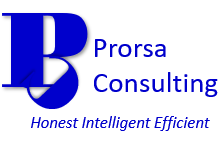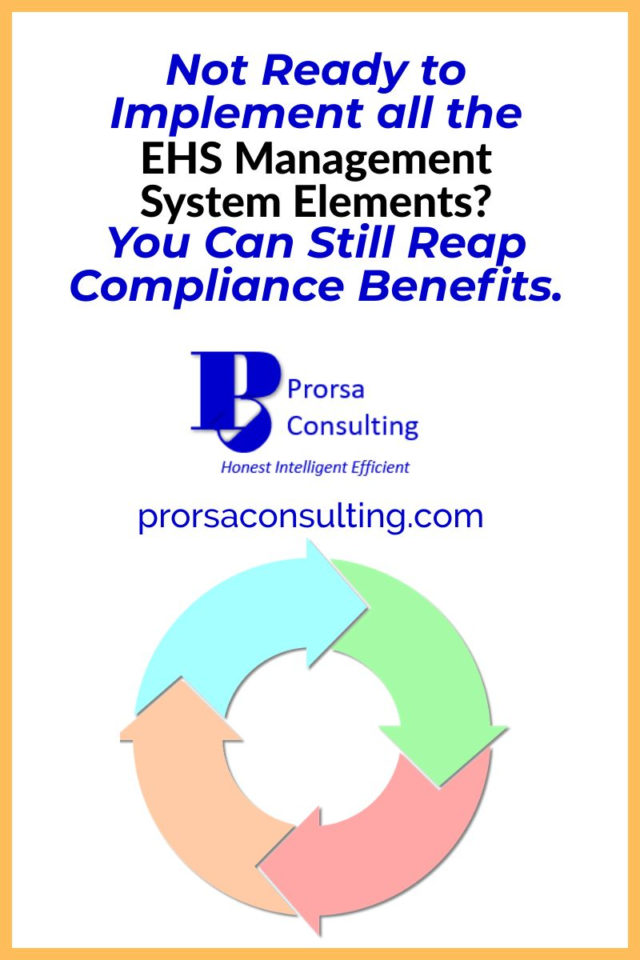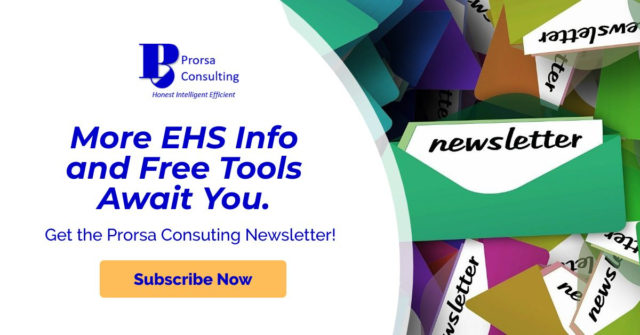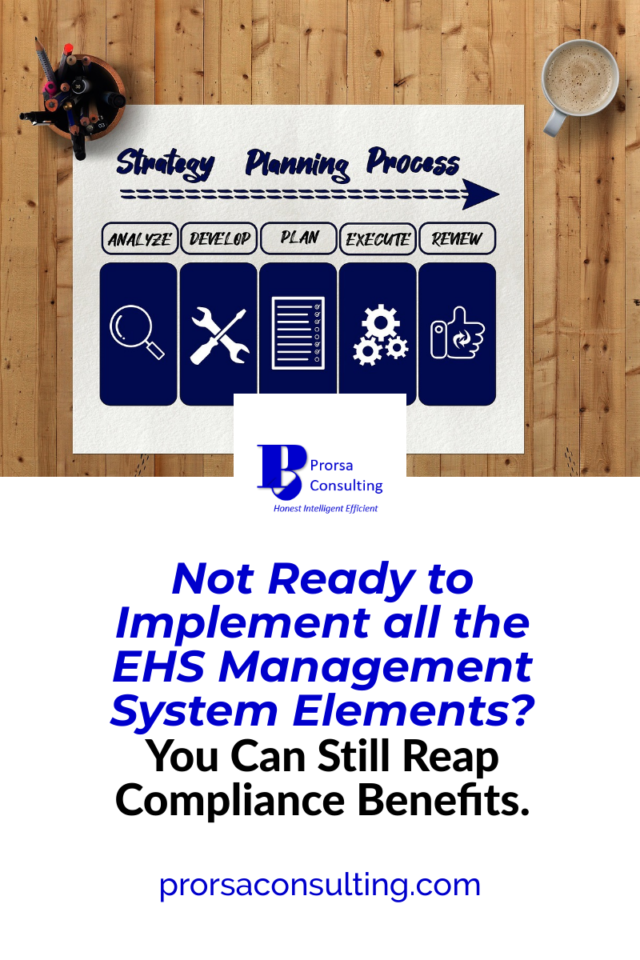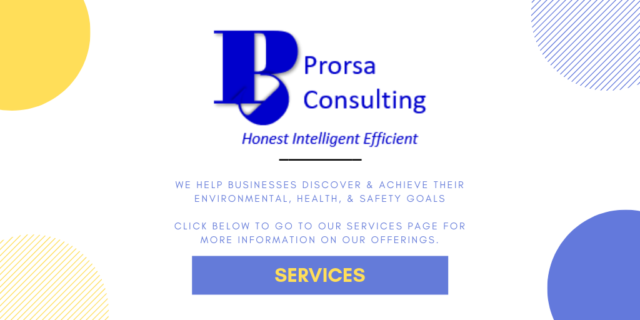Not Ready to Implement all the EHS Management System Elements? You Can Still Reap Compliance Benefits.
By : Admin -
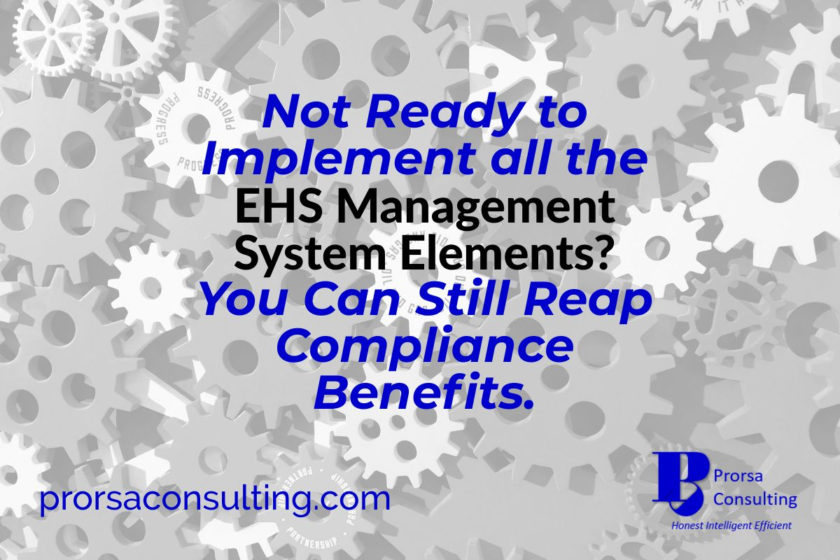
Management systems provide an organized way to enhance environmental and safety compliance.
However, not every organization has the resources readily available to implement all EHS management system elements fully. Yet, these circumstances should not prevent facilities from striving to gain greater compliance.
Strategically employing parts of a formal management system can assist organizations with performance improvement. Don’t let the resource commitment of a complete implementation stop you from attaining your EHS goals.
Keep reading for an introduction to several EHS processes to implement for enhanced compliance.
EHS Management System Elements for Compliance 1: Identify Legal Requirements
Companies cannot responsibly manage compliance if they do not know their regulatory requirements.
Often, these mandates appear in several separate places like permits, plans, regulations, statues, etc. Thus, having a consolidated EHS ‘legal clearinghouse’ can help to save time and effort.
Once compiled, this EHS regulatory information can be made readily available to all who may need the information.
Additionally, a firm grasp on a site’s requirements makes it easier to ensure mandates get adequately integrated into the EHS program. Compliance prevention efforts can benefit enormously from this one step.
What strategies for EHS management system elements can businesses use to capture their legal obligations?
Many management systems adopt a register of legal requirements to gather all regulatory obligations in one place. Organizations can create the record as a simple Microsoft Word or Excel document. Also, the listing can vary in complexity as deemed necessary by the facility.
In conjunction with the register, you may find it helpful to set up a compliance calendar. This tool will help to layout compliance activities for efficient completion. Moreover, the calendar can send task notification reminders to the person(s) responsible for job closure.
Organizations have some choice in how to manage compliance tasks via a calendar method. Many EHS management software companies provide tools to track regulatory tasks. Likewise, companies can design an in-house solution via Microsoft Outlook, Asana, or ClickUp.

Image by Pixabay on Pexels.
EHS Management System Elements for Compliance 2: Improve Control of Documents and Records
Facilities will have a challenging time fulfilling their EHS regulatory responsibilities without written documentation.
Businesses find no profit in preparing required recordkeeping only to be unable to find it when needed. Document and record controls help to combat this potential scenario.
Moreover, managing documentation well helps to support robust communication within the workforce. With a sound system, everyone will know where and how to access essential documents, operating procedures, plans, training references, etc.
Having a robust control mechanism will help sites ensure documentation stays current. It also prevents the potential for unauthorized versions of written materials.
How can an organization improve its control of documents and records?
Developing a standard operating procedure on the control of documents and records presents as a logical addition to any set of EHS processes. The written instruction should include responsibilities for those authoring, controlling, and authorizing EHS-related paperwork.
Furthermore, facilities should designate official locations for EHS recordkeeping. These physical and electronic places should be communicated widely and included in the procedure.
Also, this EHS management system element should contain a mechanism to ensure periodic reviews and updates of written EHS documentation. Performing this exercise provides an opportunity to keep materials up-to-date and relevant.
EHS Management System Elements for Compliance 3: Employee Participation
Employees’ knowledge and skills provide invaluable support to maintain and enhance performance.
Organizations cannot leverage workers’ talent if chances to participate in EHS are few and far between. Likewise, a lack of involvement prevents individuals from taking the ownership necessary for successful EHS.
Better participation may also improve morale and the overall EHS culture within a facility. Employees will feel they have a larger stake in environmental and safety compliance. In turn, persons will gain the motivation to work harder and meet goals.
How can organizations get workers more involved in EHS compliance?
Any action starts with awareness. As such, companies need to keep employees informed when it comes to EHS compliance performance. Providing workers with this information helps prompt the behavioral changes required to improve execution.
Next, individuals should have growth opportunities. Tasks like inspections, training, committees, and procedure development can provide the possibility for greater worker involvement in EHS processes.
Employees can also gain exposure to tasks outside their regular work duties, leading to increased professional development.
Moreover, businesses should evaluate the means utilized to encourage and receive employee input into EHS. Workers need open communication lines through which to offer comments, feedback, and suggestions.
Furthermore, individuals should be able to provide environmental and safety input comfortably and without fear of reprisal.
EHS Management System Elements for Compliance 4: Inspections and Auditing
Weak areas in an EHS compliance program do not raise their hands to identify themselves.
So, organizations actively need to seek these weaknesses. Performing inspections and audits provide the vehicles to do just that.
Conducting regular reviews of on-site conditions and processes will naturally uncover compliance improvement opportunities. Likewise, businesses can utilize these exercises to identify successes for recognition and celebration.
Also, inspections and audits can help raise the visibility of EHS within a facility. With greater visibility, an organic focus on environmental and safety compliance can develop.
What best practices exist to implement compliance inspection and auditing?
The best inspections and auditing programs possess standard protocols to guide the examinations. Correspondingly, the checks occur on a regular schedule.
Take a collaborative approach when inspecting and auditing. These activities provide excellent opportunities for worker participation, so make the most of them.
Finally, inspectors and auditors need to maintain objectivity. Remember, compliance improvement is the goal. You cannot reach this target if biases prevent potential regulatory issues from being uncovered.

Image by Brook Anderson on Unsplash.
EHS Management System Elements for Compliance 5: Preventative and Corrective Actions
Poor EHS compliance thrives in an environment where adverse outcomes happen without any intervention or follow-up.
Preventative and corrective actions form the foundation of stellar continuous improvement. Companies must identify the root causes of compliance failures to implement these actions adequately.
With this causal knowledge, companies can develop and execute proper solutions. Current non-compliance issues resolve, and future occurrences get prevented. Moreover, the company’s fulfillment of regulatory obligations improves as incidents of non-compliance decrease.
What items should companies incorporate into a preventative and corrective action process for increased EHS compliance?
These EHS management system elements work only when unsatisfactory compliance outcomes receive investigation. The facility should uncover all relevant facts during the probes.
The reason (the why or cause) behind a non-compliance event should reveal itself through assessment of the investigative data collected. The evaluation, or root cause analysis, will help to focus operations on what needs fixing. Likewise, the review should point to an acceptable solution.
Finally, businesses should keep track of preventative and corrective action implementations as part of their EHS processes. This step will ensure the timely and proper execution of solutions.
Additionally, do not neglect an examination of how the chosen actions performed. By conducting appropriate follow-up, organizations will have the information to make the changes needed to achieve and maintain a superior level of regulatory compliance.

Image by: Werner Heiber on Pixabay.
EHS Management System Elements for Compliance 6: Management Review
You cannot overstate the importance of the top leadership’s role in EHS compliance.
An organization’s senior leaders set the tone for how to conduct business throughout the organization. Establishing a management review process can stimulate the top-level involvement needed to enhance EHS compliance.
The organization’s senior management ultimately has the decision-making power when it comes to initiatives undertaken and the resources allocated to meet goals. Therefore, these individuals should have an exceptional understanding of the organization’s EHS compliance challenges.
What items should companies incorporate into a management review process for increased compliance?
Top managers should review compliance-related items on a regular schedule. Furthermore, a list of topics will help to keep things organized. The itinerary should include items like:
- Applicable new regulatory requirements
- Results of audits and inspections (agency and internal)
- Status of corrective and preventative actions
- Employee feedback and suggestions
- EHS key performance indicators (leading and lagging)
As with the other EHS management system elements, improved compliance remains the goal of management review.
Therefore, senior managers should objectively look at the data presented and decide which changes to current EHS processes will garner greater compliance.
As the EHS compliance program changes, the approvals coming out of the management review process should receive clear mandates from top leadership. The decisions must be communicated clearly to all levels of the organization.
Additionally, senior leaders must allocate adequate resources to support the implementation of the changes resulting from the review. Proper execution of management’s decisions will stifle without the money, staff, time, and materials needed for success.
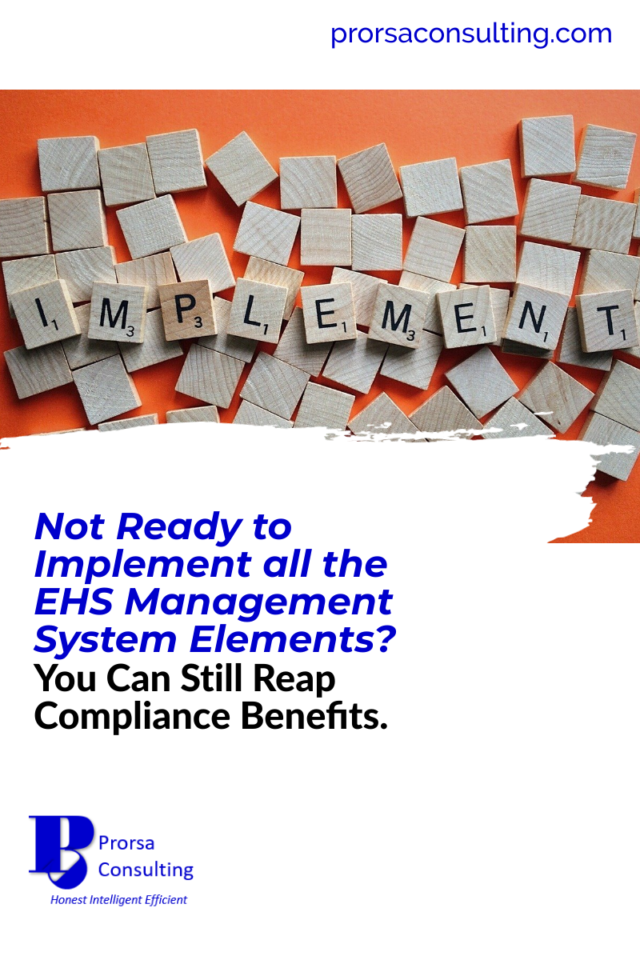
Related EHS Management Posts for You
Practical EHS Management System Basics & Tips to Get You Out of the Gate
Start Negotiating for EHS Management Systems Like the Pro You Are
Top Management Commitment in EHS: The Surprise Defense to A Deficient Culture
EHS Compliance Benefits to Know and Always Welcome in Your Operations
6 Hot EHS Trends to Explore in 2024
Concluding Thoughts
Compliance programs can benefit from EHS management system elements. Moreover, improvement does not require full management system implementation.
A focus on regulatory requirements, document controls, and worker involvement aids in the planning and doing for compliance success.
Inspections and auditing serve to check compliance progress. Subsequently, preventative and corrective actions, along with management review, provide the means to act for future enhanced results.
So, do you think EHS management system elements have a place outside of a full implementation?
Feedback on this blog is encouraged. Please comment, like, and share below if you enjoyed this content. You can also provide your feedback via the Contact Us page.
Also, don’t forget to follow Prorsa on LinkedIn, Pinterest, and Twitter!
Prorsa Consulting helps regulated companies assess, maintain, and enhance their operations’ environmental and safety compliance.
Do you want help in enhancing your EHS efforts through more updates and access to our resource library? Just subscribe to the Prorsa Consulting Newsletter for free below.
